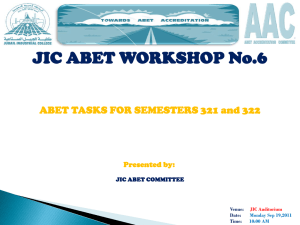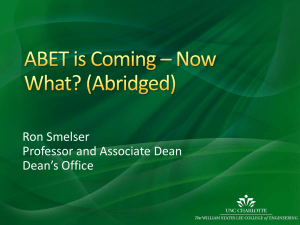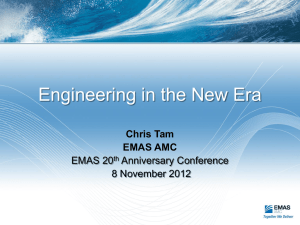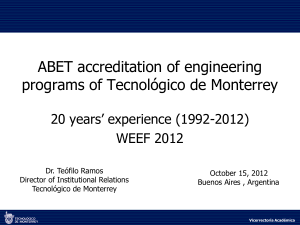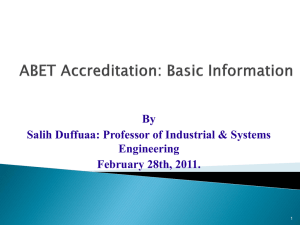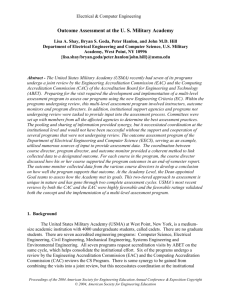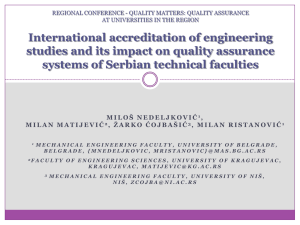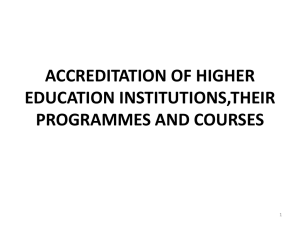slide set
advertisement
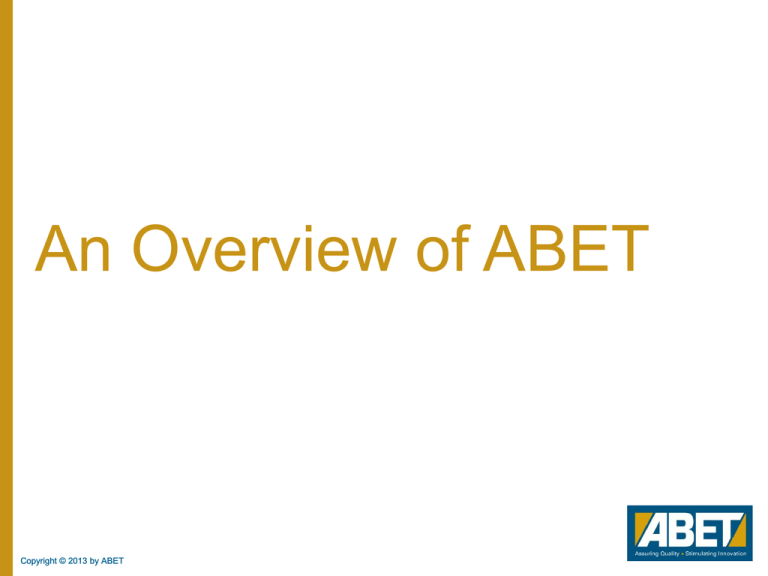
An Overview of ABET Copyright © 2013 by ABET 2 ABET Overview • ABET is a federation of 32 professional engineering and technical societies. • Neither institutions nor individuals are members of ABET. • ABET accredits educational programs. • ABET relies on the services of almost 2,200 volunteers supported by 33 fulltime and 5 part time-staff. Copyright © 2013 by ABET ABET’s 32 Member Societies 4 Organization Structure Accreditation Council ABET Board Committees Industry Advisory Council Academic Advisory Council Global Council Applied Science Accreditation Commission Computing Accreditation Commission Engineering Accreditation Commission Engineering Technology Accreditation Commission 71 accredited 381 accredited 2,209 accredited 633 accredited programs at 54 programs at 299 programs at 456 programs at 213 institutions institutions institutions institutions (* 1/1/1) (* 31/22/15) (* 259/53/20) (* 33/6/4) Copyright © 2013 by ABET (* Programs/Institutions/Countries Outside U.S.) 5 What Led to Accreditation in the early 1900s? • Inequity of compensation between Engineering and other professions • Employer’s need to know the value of an engineering education • Organizations like AIChE attempting to accredit by themselves • A call to “enhance the professional status of the engineer.” Copyright © 2013 by ABET 6 Push for Accreditation ~1900 Inequity of compensation and employer demand to know education value Copyright © 2013 by ABET 1908 AIChE committee attempts to standardize chemical engineering education with little consensus 1930 1932 1936 Wickendon Report recommends the creation of an organization to standardize and review programs ECPD (today ABET) forms to First Programs accredited at 35 engineering schools “enhance the professional status of the engineer1” 1ABET 75th Anniversary Retrospective 7 Becoming the Gold Standard • ABET accreditation’s prevalence grew through the 20th century • Non-accredited programs recognized the crucial role that accreditation played in producing competitive graduates • First international mutual recognition agreement signed in 1980 • EC2000 changed accreditation from installing requirements to assessing student outcomes Copyright © 2013 by ABET 8 Engineering Criteria 2000 “EC 2000” • Purpose Enhance the non-technical skills graduates lacked • Philosophy: “Outcomes-based” • Commitment to Continuous Improvement • Student, faculty, facilities, institutional support, and financial resources linked to Program Objectives Copyright © 2013 by ABET 9 General Criteria • Fulfill ABET’s obligation to ensure each graduate’s capacity to work as an engineer • Define the skills and abilities that are required generally of any engineering profession (math, problem solving, teamwork) Copyright © 2013 by ABET 10 Program Specific Criteria • Lay out the curricular requirements specific to a discipline • Developed and proposed by societies, they are an avenue for influencing specific fields • Bring programs under the purview of concerned societies Copyright © 2013 by ABET 11 How ABET Serves Societies • Program Specific Criteria Are designed to be a vehicle for societies to affect the education of their profession • ABET Structure Minimizes Cost By aggregating the accreditation responsibilities of over 3,100 programs and all 32 societies Copyright © 2013 by ABET 12 ABET Is Engaged Globally Consistent with ABET’s Mission & Vision • Assistance: MOUs with 15 national agencies • Mutual Recognition Agreements Engineers Canada International Engineering Alliance (IEA) Washington Accord, Sydney Accord, Dublin Accord Seoul Accord • Membership in Global Organizations Global Engineering Deans Council (GEDC) Intl Federation of Engineering Education Societies (IFEES) Copyright © 2013 by ABET 13 International Accreditation Growth 450 400 350 300 250 200 150 100 50 0 371 268 445 324 181 33 79 2007-082008-09 2009-10 2010-11 2011-12 2012-13 2013-14 (est.) (est.) Non-U.S.: 324 programs at 64 institutions in 23 countries Copyright © 2013 by ABET 14 What Drives Global Demand? • Corporate globalization Necessitates internationally recognized degrees ABET is internationally recognized as the gold standard in technical accreditation • International Study ABET accredited programs around the world High international demand for graduate study in the U.S. ABET accreditation is a benchmark for accepting international students around the world Copyright © 2013 by ABET 15 Takeaways • ABET Accreditation: Ensures quality education to enhance the professional status of the engineer • General Criteria: Ensure the capacity of programs to produce work ready engineers • Program Criteria: Allow societies to define the curricular requirements of their disciplines • ABET’s international presence is continuously expanding to meet global demand Copyright © 2013 by ABET
